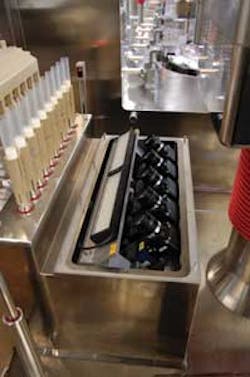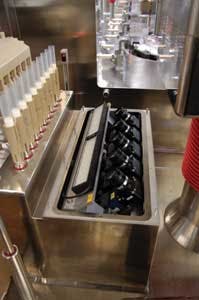FACTORY AUTOMATION: Vision vets plastic pharmaceutical packages
Pharmaceutical and medical product manufacturing mandates the development of specialized automated machinery that operates in cleanroom environments. With more than a quarter of a century of experience in developing integrated system solutions and customized machines for the pharmaceutical, chemical, and food industries, Harro Höfliger Verpackungsmaschinen (Allmersbach, Germany) recently developed a machine to automatically orient, fill, and seal plastic pharmaceutical tubes. Working with Stemmer Imaging (Puchheim, Germany), Harro Höfliger's engineers also designed the system to ensure that printed labels applied to the tubes at a later stage are always located in the same place so they can be easily read.
A vision alignment and rotation station co-developed by the two companies is responsible for properly orienting the tubes. After the tubes are transported into the station along a horizontal conveyor, they are moved to an upright position with the tube caps facing downward. A gripper then seizes 10 tubes at a time and deposits them into containers where they can be oriented correctly by rotating them around their longitudinal axes.
During this process, fiveGenie CMOS cameras from Teledyne DALSA (Waterloo, ON, Canada)—each one fitted with a HF35HA 35-mm lens from, Fujinon (Wayne, NJ, USA)—simultaneously capture images of two tubes (see figure). Images are transferred over a Gigabit Ethernet interface to two PCs running VisionPro software from Cognex (Natick, MA, USA). The software identifies the orientation of the seals on the tubes, and the results are used to rotate the tubes to ensure that the seals are positioned correctly.
When the plastic tubes are illuminated by an LED light source, light reflected from the straight edges of the tube seals is brighter than the light reflected from the rest of the body. By using feature detection and feature extraction algorithms, the points in the digital image at which the image brightness changes sharply or has discontinuities can be identified and the tubes rotated accordingly.
Detecting the white semi-transparent tube edges is complicated because the edges need to be identified against the silver steel background and the glass panes in the machine. Tests performed during the design phase showed that two blue LDL2-146 x 30LED light sources from CCS America (Burlington, MA, USA) provided the best contrast between the tubes and the background.
Furthermore, the pivoting tools of the machine protrude into the camera's field of vision. These brilliant chrome pivoting tools create reflections while moving, which are removed by combining edge detection and histogram vision software tools in the Cognex VisionPro software.
The 1024 × 768-pixel Genie cameras used provide the necessary frame rate—about 110 frames/s. However, as only part of the image is needed for tube alignment, the cameras are operated in partial-scan mode, allowing the frame rate to be increased to image more than 220 tubes per minute.
As the cameras, lenses, and lights have been installed under glass, the cameras are angled to prevent light reflection. To solve this problem, 90° angled heads are attached to each camera body. All five cameras are angled at 45° to image the tube array. Because the system was designed for cleanroom applications, the hardware was installed in a coated housing specially developed by Harro Höfliger for easy cleaning.
Harro Höfliger has also developed a number of other machine-vision and automation systems specifically built for blister-pack, pharmaceutical, and syringe/injection applications as well as pharmaceutical capsule and powder filling machines.

